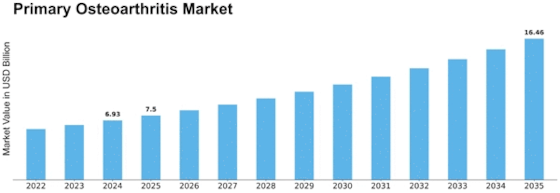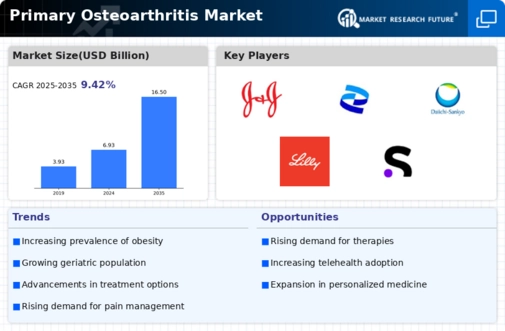Primary Osteoarthritis Size
Primary Osteoarthritis Market Growth Projections and Opportunities
The market size for primary osteoarthritis is expected to reach USD 12.49 billion at a CAGR of 9.8% during the forecast period ending in 2030. The various market factors that shape the Primary Osteoarthritis market collectively influence its dynamics. As people grow old, they are more liable to develop primary osteoarthritis- a degenerative joint disease. Moreover, there is an increasing elderly population, coupled with sedentary lifestyles and obesity, which has led to higher prevalence of primary osteoarthritis. These demographic changes drive treatment demand and affect the growth trajectory of the market for primary osteoarthritis.
Primary Osteoarthritis market is shaped by variety of factors including regulatory factors such as strict guidelines on approval process helps to ensure safety and efficacy of medications or medical devices used in management of Primary Osteoarthritis. For example, regulatory approval instills confidence among healthcare professionals and patients about safety and effectiveness of these interventions. New products entering into market have therefore to comply with regulatory guidelines set by respective bodies where pharmaceutical industries must adhere to compliance rules required for new products in the market.
Another critical factor affecting this market is economic factor like affordability and accessibility that determine adoption rates across different demographics. The affordability of treatments and surgeries depends on economic conditions, healthcare expenditure patterns, and insurance coverage that together affect a person’s ability to access prescribed interventions for managing primary osteoarthritis. Thus, there is need to consider economic implications before deciding on expansion or integration into routine clinical practice.
This also impacts the market of Primary Osteoarthritis in terms of technological advancement in surgical procedures and medical devices. These range from joint replacement surgeries to minimally invasive procedures or advanced prosthetics that help in improving patient outcomes and recovery. This procedure improvement has not only increased treatment efficiency but also allowed for less invasive and painless surgery options for primary osteoarthritis.










Leave a Comment